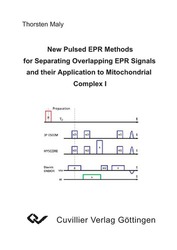| Departments | |
|---|---|
| Book Series (96) |
1378
|
| Nachhaltigkeit |
3
|
| Gesundheitswesen |
1
|
| Humanities |
2364
|
| Natural Sciences |
5406
|
| Mathematics | 229 |
| Informatics | 319 |
| Physics | 980 |
| Chemistry | 1363 |
| Geosciences | 131 |
| Human medicine | 243 |
| Stomatology | 10 |
| Veterinary medicine | 108 |
| Pharmacy | 147 |
| Biology | 835 |
| Biochemistry, molecular biology, gene technology | 121 |
| Biophysics | 25 |
| Domestic and nutritional science | 45 |
| Agricultural science | 1004 |
| Forest science | 201 |
| Horticultural science | 20 |
| Environmental research, ecology and landscape conservation | 148 |
| Engineering |
1793
|
| Common |
98
|
|
Leitlinien Unfallchirurgie
5. Auflage bestellen |
|
Advanced Search
New Pulsed EPR Methods for Separating Overlapping EPR Signals and heir Application to Mitochondrial Complex I (English shop)
Thorsten Maly (Author)Preview
Table of Contents, Datei (65 KB)
Extract, Datei (160 KB)
One of the main topics of this thesis is the investigation of ironsulphur clusters of complex I from Y. lipolytica by pulsed EPR. The structural environment of the clusters N1 and N2 is probed using pulsed EPR techniques (ESEEM, ENDOR, HYSCORE etc.). Unfortunately, it is not possible to investigate the biologically interesting ironsulphur cluster N2 of complex I alone, because the EPR spectrum of cluster N1 is almost completely overlapping with the spectrum of cluster N2. To overcome this problem, a new pulsed EPR method is developed as part of this thesis to separate the contributions of different paramagnetic species based on differences in their relaxation behaviour. For the first time the possibility is shown, that an inversion-recovery filter can be used in a pulsed EPR experiment to separate the spectral contributions from different paramagnetic species. This technique is first demonstrated using the two model compounds BDPA and Tempo(PS) in order to obtain the individual echo-detected field-swept spectra of these two components from a mixture. With this novel method applied to complex I from Y. lipolytica, it is possible for the first time to record individual EPR spectra of the iron-sulphur clusters N1 and N2 within one sample at the same temperature – an experiment, which cannot be performed using cw-EPR spectroscopy. Simulations of the obtained inversionrecovery detected field-swept spectra of cluster N1 and N2 show that the g values are similar to those previously obtained by cw-EPR and given in the literature.
| ISBN-13 (Printausgabe) | 3865372961 |
| ISBN-13 (Hard Copy) | 9783865372963 |
| ISBN-13 (eBook) | 9783736912960 |
| Final Book Format | A5 |
| Language | German |
| Page Number | 252 |
| Edition | 1 Aufl. |
| Volume | 0 |
| Publication Place | Göttingen |
| Place of Dissertation | Frankfurt |
| Publication Date | 2004-12-19 |
| General Categorization | Dissertation |
| Departments |
Chemistry
Pharmacy |








